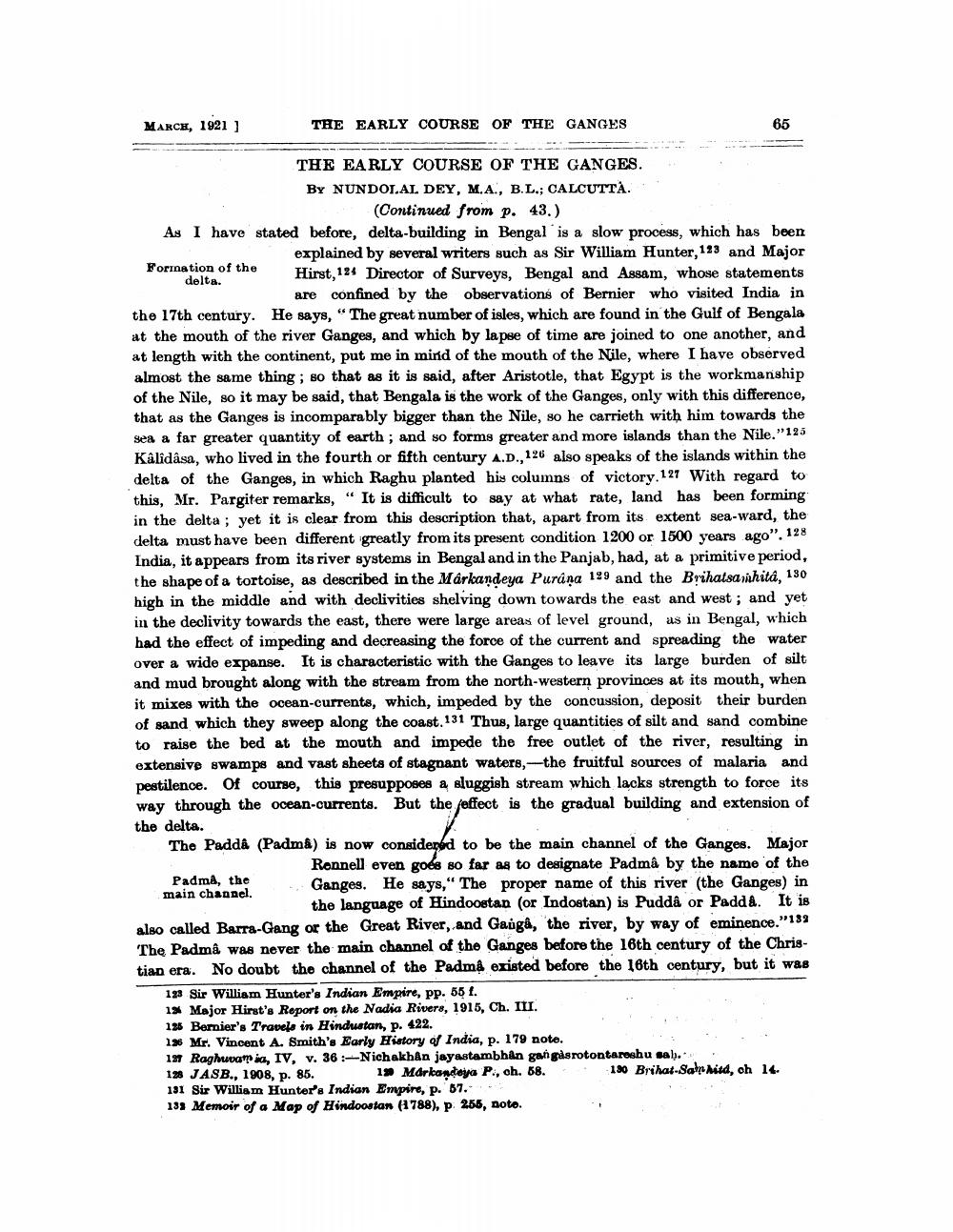________________
Marce, 1921)
THE EARLY COURSE OF THE GANGES
65
THE EARLY COURSE OF THE GANGES. BY NUNDOLAL DEY, M.A., B.L.; CALCUTTÀ.
(Continued from p. 43.) As I have stated before, delta-building in Bengal is a slow process, which has been
explained by several writers such as Sir William Hunter, 123 and Major Forination of the Hirst, 124 Director of Surveys, Bengal and Assam, whose statements delta.
are confined by the observations of Bernier who visited India in the 17th century. He says, "The great number of isles, which are found in the Gulf of Bengala at the mouth of the river Ganges, and which by lapse of time are joined to one another, and at length with the continent, put me in mind of the mouth of the Nile, where I have observed almost the same thing; so that as it is said, after Aristotle, that Egypt is the workmanship of the Nile, so it may be said, that Bengala is the work of the Ganges, only with this difference, that as the Ganges is incomparably bigger than the Nile, so he carrieth with him towards the sea a far greater quantity of earth; and so forms greater and more islands than the Nile."125 Kalidasa, who lived in the fourth or fifth century A.D., 126 also speaks of the islands within the delta of the Ganges, in which Raghu planted his columns of victory. 127 With regard to this, Mr. Pargiter remarks, “It is difficult to say at what rate, land has been forming in the delta ; yet it is clear from this description that, apart from its extent sea-ward, the delta must have been different greatly from its present condition 1200 or 1500 years ago". 128 India, it appears from its river systems in Bengal and in the Panjab, had, at a primitive period, the shape of a tortoise, as described in the Markandeya Purana 139 and the Brihatsanhita, 130 high in the middle and with declivities shelving down towards the east and west ; and yet in the declivity towards the east, there were large areas of level ground, as in Bengal, which had the effect of impeding and decreasing the force of the current and spreading the water over a wide expanse. It is characteristic with the Ganges to leave its large burden of silt and mud brought along with the stream from the north-western provinces at its mouth, when it mixes with the ocean-currents, which, impeded by the concussion, deposit their burden of sand which they sweep along the coast.131 Thus, large quantities of silt and sand combine to raise the bed at the mouth and impede the free outlet of the river, resulting in extensive swamps and vast sheets of stagnant waters,-the fruitful sources of malaria and pestilence. Of course, this presupposes a sluggish stream which lacks strength to force its way through the ocean-currents. But the effect is the gradual building and extension of the delta. The Padda (Padma) is now considerbd to be the main channel of the Ganges. Major
Ronnell even goes so far as to designate Padmâ by the name of the Padma, the
Ganges. He says, " The proper name of this river (the Ganges) in main channel
the language of Hindoostan (or Indostan) is Puddâ or Padda. It is also called Barra-Gang or the Great River, and Gauga, the river, by way of eminence."139 The Padma was never the main channel of the Ganges before the 16th century of the Christian era. No doubt the channel of the Padmâ existed before the 16th century, but it was
133 Sir William Hunter's Indian Empire, pp. 56 f. 13 Major Hirst's Report on the Nadia Rivers, 1915, Ch. III. 126 Bernier's Travels in Hindustan, p. 422. 136 Mr. Vincent A. Smith's Early History of India, p. 179 note. 19 Raghuvara. IV. v. 36 :-Nichakban jayastambhan gangasrotontaroshu sab. . 19 JASB., 1908, p. 85. 19 Markandeya P., oh. 68. . 180 Brihat-Sakr mitd, oh 14. 131 Sir William Hunter's Indian Empire, p. 67. 133 Memoir of a Map of Hindoostan (1788), p. 256, noto.




